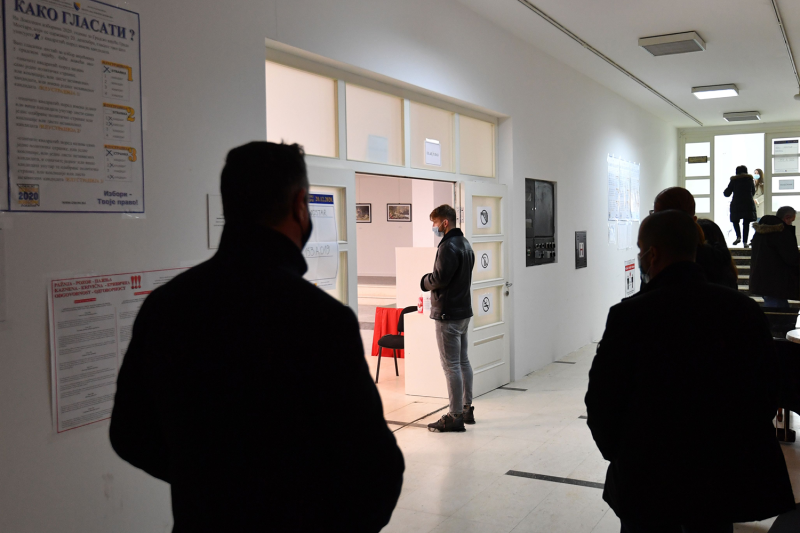Bosnia’s Paradoxical Peace Rests on a Flawed Constitution

Bosnia’s Paradoxical Peace Rests on a Flawed Constitution
The United States and European Union must step up for reform.
Voters wait in line as they arrive prior to casting their vote for local elections in Mostar, southern Bosnia and Herzegovina, on Dec. 20, 2020. Elvis Barukcic/AFP via Getty Images
This December will mark the 30th anniversary of the signing of the most paradoxical contemporary peace treaty: the U.S.-brokered Dayton Agreement. Dayton definitively ended the 1992-95 Bosnian War, which until the 2022 Russian invasion of Ukraine was the deadliest conflict in Europe since the end of World War II, accompanied by the first genocide on the continent since the Holocaust.
The peace has held—just about. But the sectarian power-sharing regime embedded in the agreement is flagrantly discriminatory and dysfunctional and has kept the country teetering on the edge of political crisis and renewed conflict ever since. In fact, Bosnian Serb secessionists are in the midst of another putsch attempt as we speak.
This December will mark the 30th anniversary of the signing of the most paradoxical contemporary peace treaty: the U.S.-brokered Dayton Agreement. Dayton definitively ended the 1992-95 Bosnian War, which until the 2022 Russian invasion of Ukraine was the deadliest conflict in Europe since the end of World War II, accompanied by the first genocide on the continent since the Holocaust.
The peace has held—just about. But the sectarian power-sharing regime embedded in the agreement is flagrantly discriminatory and dysfunctional and has kept the country teetering on the edge of political crisis and renewed conflict ever since. In fact, Bosnian Serb secessionists are in the midst of another putsch attempt as we speak.
There is a path forward for Bosnia and Herzegovina, however. And it does not require scuttling the Dayton Agreement in its entirety, only reforming Annex IV: the country’s constitution.
Getting to such an initiative first requires recalling the scale of the original task. The human and material toll of the Bosnian War was staggering: the deaths of 100,000 people, the displacement of fully half the population, and the destruction of most of the country’s major infrastructure. Bosnia was the site of NATO’s first-ever combat operations and the primary impetus behind the creation of the first international war crimes tribunals since Nuremberg and Tokyo.
Yet once the then presidents of Bosnia, Croatia, and Serbia signed Dayton, it stuck. No other major post-1945 peace agreement has been as successful in that regard.
After an initial deployment of 60,000 NATO troops in late 1995 to enforce the agreement, today there are only 1,100 lightly armed Europeans in Bosnia as part of the EUFOR Althea mission. Bosnia is now an EU candidate state and a NATO candidate, and its society and economy have recovered to that extent that National Geographic readers named Sarajevo, the Bosnian capital, their top tourist destination in 2025.
As a peace agreement, Dayton is the international gold standard. But Dayton was not just an armistice; the Bosnian Constitution, contained within the agreement, has remained a festering political quagmire.
The original logic of the Dayton Agreement was to provide each of the warring factions with a political buy-in but also force them to make significant concessions to end the war. The Bosnian government secured the preservation of Bosnia’s sovereignty as a single international subject and the reintegration of all breakaway regions into a single state. In exchange, it agreed to an extraordinary level of decentralization within Bosnia, giving Serb and Croat nationalists vast degrees of autonomy. The United States and its international partners guaranteed to uphold the integrity of the agreement but also to shepherd a process of reform that would eventually create a more functional governance regime in the country.
That delicate balance of commitments worked for the first decade after the war because the international community committed itself to making the deal work. Between 1996 and 2006, Bosnia adopted a single currency and state tax regime, a single license plate regime, a state police force, a unified armed forces, a judicial court and state prosecutor, and a litany of other reforms that rapidly pushed the country toward compatibility with EU and NATO governance standards.
The success of these efforts was such that by 2006 both the United States and the EU had begun to significantly reduce their political and diplomatic mediation efforts in Bosnia. But they grossly miscalculated because while certain key state institutions had been established, the actual division of power within the Bosnian constitutional regime was entirely on the side of the separatist elements that, while representing a minority of the population, could nevertheless rely on the legion of veto mechanisms available within the system to shut down any additional reforms and even roll back those that had been enacted.
As those efforts by Serb and Croat nationalists to disintegrate Bosnia’s postwar political order accelerated after 2006, civil rights activists began mounting their own legal campaign at the European Court of Human Rights (ECtHR) and the Bosnian Constitutional Court, targeting the ethnic power-sharing modalities that underpin most of the veto mechanisms and other associated sectarian features of the Bosnian constitutional regime, which have allowed the separatists to derail the country’s reform path.
As of 2025, nearly every major representative facet of the Bosnian Constitution—and the constitutions of the country’s two chief administrative units, the Federation of Bosnia and Herzegovina and Republika Srpska—has been struck down as discriminatory and democratically illegitimate by the ECtHR and/or the Bosnian Constitutional Court.
Namely, because the organizing principle of postwar Bosnia is not popular representation but sectarian power-sharing. This practice reserves virtually all significant forms of legislative and executive power to the so-called constituent peoples (i.e., Bosniaks, Serbs, and Croats) at the expense of all other groups and individuals in the country, including those who simply identify as citizens of the Bosnian state but also minorities such as Jews and the Romani.
This is an explicit violation of the writ of the European Convention on Human Rights, one of the foundational legal treaties of the contemporary European order, which itself is embedded directly into Article 2.2 of the Bosnian Constitution, stating that the “rights and freedoms set forth in the [convention] shall apply directly in Bosnia and Herzegovina. These shall have priority over all other law.”
In other words, the sectarian power-sharing dimensions of the Bosnian Constitution are in direct conflict with its commitments to the civic and democratic equality of all citizens. Despite a series of landmark rulings by the ECtHR since 2009 against the Bosnia state on these grounds, the most significant of which is its 2023 Kovacevic decision, there has been no meaningful movement constitutional reform.
The reasons are simple.
The entrenched, ethnically constituted ruling class in Bosnia does not want to democratize the country’s constitutional regime because they, correctly, conclude that it would diminish their political power. Instead, Croat and Serb nationalist hard-liners have used the expansive ethnic vetoes and tripwires embedded in the existing constitutional system to all but derail any semblance of rational governance.
Bosnian Serb secessionist leader Milorad Dodik, for instance—a close ally of Russia’s Vladimir Putin and Serbia’s Aleksandar Vucic—has routinely threatened to break up the country, resulting in U.S. and U.K. sanctions against virtually his entire regime and even a U.S. flyover of the country in 2024. Currently, he is engaged in his most radical assault on the Bosnian state yet, having enacted a decree banning the work of the state police and state courts in the territory of Republika Srpska. The move is flagrantly unconstitutional and a clear violation of the Dayton Agreement. Worse, it is pushing Bosnia to the brink of institutional collapse and the threat of renewed conflict.
Still, as elusive as the prospects of substantive constitutional reform in Bosnia have seemed for much of the past three decades, the political formula is hardly alchemical. I spelled out its contents in detail in a February policy report, providing both a political road map and a set of concrete proposals for achieving constitutional reform in Bosnia that could be made acceptable to all relevant stakeholders.
Getting to such a possibility first requires a comprehensive commitment to achieving constitutional reform by genuine pro-EU and pro-NATO elements in Sarajevo, which are chiefly represented by the country’s multiethnic and ethnic Bosniak political parties, respectively. On paper, these parties constitute as much as 60 percent of the lower chamber of the Bosnian Parliament.
If these parties can agree to a basic program, an ad hoc coalition should be offered to the country’s ethnic Serb and Croat opposition parties, which are already signaling their willingness to break with the dominant nationalist leadership within their communities. In fact, Serb opposition leaders in Republika Srpska have been some of the most steadfast in their criticisms of Dodik’s current adventurism.
Once the pillars of such a coalition for constitutional reform are created, it could then approach the United States and EU—currently at loggerheads but with a shared strategic interest in the long-term pacification of the Western Balkans—and ask for their political and technical assistance with the process. If the Trump administration is unwilling or unable to assist, the EU and its key capitals must step up. And if the EU is unable to act with determination in Bosnia, then it has no hope whatsoever of dealing with the likes of Russia or China.
Politically, the major ask would be to keep Serbia, Croatia, and their respective local proxies from imploding the initiative. Their acquiescence can be achieved through a combination of credible threats of sanctions or other political penalties (e.g., scuttling visa-free travel to the United States for Croatian nationals or halting EU development funds to Serbia). Technically, Washington and Brussels should guide the relevant actors in Bosnia to ensure that the contents of their agreement are sufficient to accelerate the country’s path toward EU and NATO membership.
The easiest technical plan would be to adopt a version of the 2006 April Package, a proposal that only narrowly failed to win adoption in the lower chamber of the Bosnian Parliament, updated to address the rulings of the ECtHR and the Bosnian Constitutional Court since then.
There should be no moves toward the country’s territorial reorganization at this time—which is problematic and inefficient but not an immediate priority—and the focus should be entirely on creating more rational, accountable, and democratic governance modalities, in line with the human rights convention, at the state level.
If Bosnia could finally enact substantive constitutional reform, the positive outcomes for both the country’s citizens and the international community would be legion.
It would improve the quality of governance and allow for a new, liberal political class to emerge; it would convince citizens and political officials alike that reform, even structural reform, is possible in Bosnia, creating incentives for further reform initiatives, helping to curb emigration; and it would create a competent administrative regime capable of actually realizing Bosnia’s EU and NATO aspirations, and that, in sum, would permanently foreclose any possibility of the country’s dissolution or annexation.
And if Bosnia ceases to become a concern for the international community, that leaves far greater resources for both Washington and Brussels to deal with the region’s other major problem, the Kosovo-Serbia dispute, or the plethora of other geopolitical crises that currently concern the West.
As ever, all of this depends, fundamentally, on the political will to act.
The upcoming spring session of the NATO Parliamentary Assembly in Dayton, Ohio, is an opportunity for both senior Bosnian officials and their counterparts in Washington and the European capitals to socialize this program and even to make the first moves toward its realization ahead of next year’s general elections in the country.
Such plainly stated optimism may seem naive, but it is sober realism compared with the fantastical belief that Bosnia’s present dysfunction can persist in perpetuity without a resumption of violence.
Jasmin Mujanović is a political scientist specializing in the politics of southeastern Europe. He is the author of the book Hunger and Fury: The Crisis of Democracy in the Balkans. X: @JasminMuj
More from Foreign Policy
-

Indian Air Force personnel stand in front of a Rafale fighter jet during a military aviation exhibition at the Yelahanka Air Force Station in Bengaluru. A Tale of Four Fighter Jets
The aircraft India and Pakistan use to strike each other tell a story of key geopolitical shifts.
-

A cardinal in a black robe with red sash with hands folded in front of him walks past a stage and steps. Conclave Sends Message With American Pope
Some cardinals had been agitating for U.S. leadership to counter Trump.
-

An illustration shows red tape lines crossing over and entrapping a semiconductor chip. Is It Too Late to Slow China’s AI Development?
The U.S. has been trying to keep its technological lead through export restrictions, but China is closing the gap.
-

A man watches a news program about Chinese military drills surrounding Taiwan, on a giant screen outside a shopping mall in Beijing on Oct. 14, 2024. The Pentagon Fixates on War Over Taiwan
While U.S. military leaders fret about China, Trump has dismissed the Asia-Pacific.






Join the Conversation
Commenting on this and other recent articles is just one benefit of a Foreign Policy subscription.
Already a subscriber?
.
Subscribe
Subscribe
View Comments
Join the Conversation
Join the conversation on this and other recent Foreign Policy articles when you subscribe now.
Subscribe
Subscribe
Not your account?
View Comments
Join the Conversation
Please follow our comment guidelines, stay on topic, and be civil, courteous, and respectful of others’ beliefs.
Change your username |
Log out
Change your username:
CANCEL
Confirm your username to get started.
The default username below has been generated using the first name and last initial on your FP subscriber account. Usernames may be updated at any time and must not contain inappropriate or offensive language.